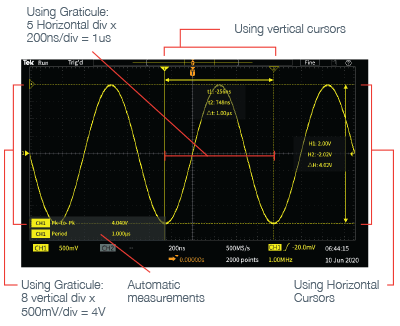

이전에 오실로그래프(속칭 스코프, 오스코프 또는 오-스포크)라고도 불렸던 오실로스코프는 전기 신호를 그래픽으로 표시하고 시간 경과에 따라 어떻게 변화하는지 보여주는 장비입니다. 오실로스코프는 사운드, 빛, 열 등의 물리적 자극에 반응하는 전기 신호를 생성하는 장치인 센서에 연결하여 이러한 신호를 측정합니다. 예를 들어 마이크는 사운드를 전기 신호로 변환하는 센서입니다.
여기에서는 오실로스코프 작동 원리부터 적합한 오실로스코프를 찾는 법까지 오실로스코프에 대한 모든 것을 다룹니다.
오실로스코프는 어디에 사용되나요?
오스코프는 전자 장비의 설계, 제조 또는 수리할 때 주로 사용됩니다. 엔지니어는 오실로스코프를 사용해 전기 현상을 측정하고 빠르게 측정 문제를 해결하여 설계를 검증하거나 센서가 올바르게 작동하는지 확인합니다.
오실로스코프는 누가 사용하나요?
과학자, 엔지니어, 물리학자, 수리 기술자 및 교육자들은 오실로스코프를 사용하여 시간 경과에 따른 신호 변화를 확인합니다. 오토모티브 엔지니어는 오실로스코프를 사용하여 센서에서 수집한 아날로그 데이터를 엔진 제어 장치(ECU)의 직렬 데이터와 상호 연계시키고, 의학 연구원은 오실로스코프를 통해 뇌파를 측정합니다. 오실로스코프는 다양한 분야에 사용할 수 있습니다.
오실로스코프는 어떻게 작동하나요?
오실로스코프 시스템에는 수직, 수평 및 트리거라는 세 가지 기본 시스템이 있습니다. 이 세 가지 시스템은 함께 전기 신호에 대한 정보를 제공하여 오실로스코프가 정확하게 신호를 재구성할 수 있습니다. 아래 그림에는 오실로스코프의 블록도가 나와 있습니다.

첫 번째 단계에서는 신호의 진폭을 최적화하기 위해 신호 전압을 감쇠 또는 증폭합니다. 수직 눈금 조절에 따라 달라지기 때문에 수직 시스템이라고 합니다. 그런 다음 신호가 수집 블록에 도달하면 아날로그-디지털 변환기(ADC)가 신호 전압의 샘플을 추출해 디지털 형식의 값으로 변환합니다. 샘플 클록이 포함된 수평 시스템에서는 각 전압 샘플에 대한 정밀 시간(수평) 좌표를 제공합니다. 샘플 클럭은 ADC를 구동하고 그 디지털 출력은 기록 포인트로서 수집 메모리에 저장됩니다. 트리거 시스템은 수신 신호 스트림에서 사용자 지정 조건을 감지하여 파형 기록에서 시간 참조로 적용합니다. 트리거 기준을 충족한 이벤트가 표시되고 이벤트 전후의 파형 데이터로 함께 표시됩니다.
셀렉션 알아보기
오실로스코프는 무엇을 측정하나요?
간단히 말해 오실로스코프는 전압파를 측정합니다. 오실로스코프 화면에서 전압은 Y축에 세로로 표시되고 시간은 X축에 가로로 나타납니다. 디스플레이의 명암 또는 밝기는 Z축이라고도 불립니다. 결과 그래프를 보면 다음을 포함해 신호에 관한 많은 정보를 알 수 있습니다.

- 신호의 시간 및 전압값
- 진동 신호의 주파수
- 신호로 표현되는 회로의 "작동 부분"
- 다른 부분에 비해 신호가 발생하는 특정 부분의 주파수
- 오작동하는 컴포넌트로 인해 신호가 왜곡되는지 여부
- 신호 중 직류(DC) 또는 교류(AC)의 양
- 신호에서 노이즈가 있는 부분
- 시간에 따른 노이즈 변화 여부
오실로스코프 vs 디지털 멀티미터 vs 전압계
오실로스코프, 디지털 멀티미터, 전압계의 차이점은 무엇이고 서로 바꿔 사용할 수 있나요? 전압계는 전기 회로에 있는 두 노드의 전위차를 측정합니다. 디지털 멀티미터는 전압과 함께 전류와 저항도 측정합니다. 그리고 오실로스코프는 시간 경과에 따라 전압이 어떻게 변하는지 보여 줍니다. 일반적으로 애플리케이션이 발전할수록 장비도 함께 발전합니다.
오실로스코프의 유형
오실로스코프에는 크게 아날로그와 디지털의 두 가지 종류가 있습니다. 아날로그 오실로스코프는 전압파를 원래의 형태로 포착하여 표시하는 반면, 디지털 오실로스코프는 아날로그-디지털 변환기를 사용하여 정보를 디지털 방식으로 포착하고 저장합니다. 오늘날 대부분의 엔지니어들은 디버깅과 설계 과정에서 디지털 오실로스코프를 사용합니다. 디지털 오실로스코프는 저렴한 범용 오실로스코프부터 기본 모델보다 가격은 더 비싸지만 고급 기능과 더 높은 정확도를 갖춘 복잡한 오실로스코프까지 다섯 가지 모델로 나뉩니다.
- Digital storage oscilloscope (DSO): This is a conventional digital oscilloscope and is ideal for low repetition-rate or single-shot, high-speed, multichannel design applications.
- Digital phosphor oscilloscope (DPO): A DPO takes a new approach to oscilloscope architecture and, unlike DSOs, provides Z-axis (intensity) in real-time. DPOs are the best general-purpose design and troubleshooting tool for a wide range of applications and are often used for advanced analysis, communication mask testing, digital debug of intermittent signals, repetitive digital design and timing applications.
- Mixed signal oscilloscope (MSO): A type of DSO, MSOs are designed to display and compare both analog and digital signals. It is the instrument of choice for quickly debugging digital circuits using powerful digital triggering, high-resolution acquisition capability and analysis tools.
- Mixed domain oscilloscope (MDO): These oscilloscopes provide the same capabilities as mixed signal oscilloscopes, but also offer a built-in spectrum analyzer, adding RF debugging to the analog and digital capabilities.
- Digital sampling oscilloscope: For very high-speed signal analysis, sampling oscilloscopes support jitter and noise analysis with ultra-low jitter acquisitions. It can achieve bandwidth and high-speed timing 10 times higher than other oscilloscopes for repetitive signals.
Read more about the types of oscilloscopes and the features of each to find the right oscilloscope for your application.
How to choose the best oscilloscope
When it comes to choosing the right oscilloscope, there are a number of factors to consider, including bandwidth, waveform capture rate, sample rate, rise time, triggering capabilities and price. Much like shutter speed, lighting conditions and aperture of a camera all affect its ability to capture an image clearly and accurately, the performance considerations of an oscilloscope significantly affect its ability to achieve the required signal integrity. To learn more about these criteria and how they might relate to your applications, read our deep dive on how to evaluate an oscilloscope.
History of the oscilloscope
In 1897, a German physicist named Karl Ferdinand Braun invented a cathode ray tube and, along with it, the first oscilloscope, which was expanded upon decades later by the company A. C. Cossor. In 1934, the first commercial oscilloscope was released by General Radio, and it became the first to be used outside of a laboratory. And in 1946, Howard Vollum and Melvin Jack Murdock founded Tektronix, which has gone on to become a world leader oscilloscopes. Since then, Tek has continued releasing innovative new technologies, including the first digital oscilloscope in 1971 and the first oscilloscope-to-cloud software solution—TekDrive—in 2020. Oscilloscopes are a staple of any engineer’s bench and have even been featured in famous films throughout history. You can visit the Tek museum website to see a complete list of oscilloscopes in films.
Oscilloscope resources
Digital oscilloscopes are the key to helping engineers meet today's demanding measurement challenges. Tektronix is the world leader in oscilloscopes and offers a variety of oscilloscopes to meet the needs of even the most advanced applications. Shop oscilloscopes today or contact a Tektronix representative to request an oscilloscope demo.
Not ready to "pull the trigger”? Download our XYZs of Oscilloscopes primer to learn everything you need to know in order to choose and use the best oscilloscope for your application.




